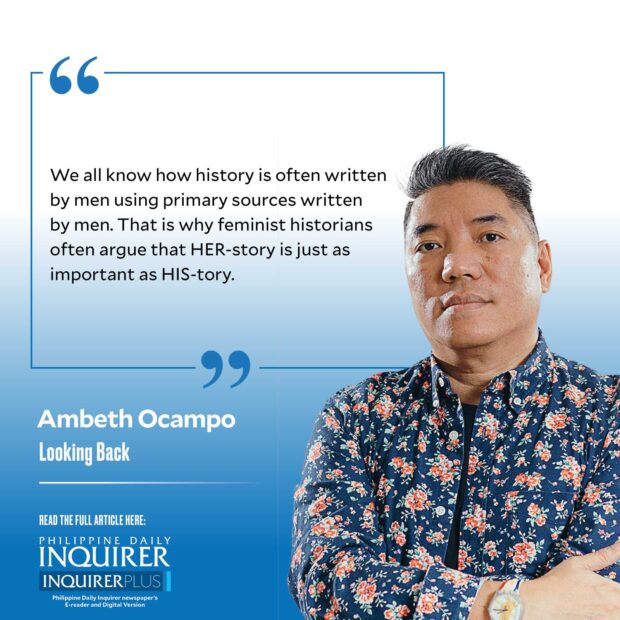Women in His-tory (Part 1)

Online shopping, food delivery, tap cards, e-wallets, work from home, Zoom meetings, and even e-burol were some of the welcome responses to pandemic lockdown that have grown into part of everyday life. Sadly, not all the gains jumpstarted by the pandemic are permanent.
Advancements in online or distance education are slowly eroding as teachers and students are being herded back for face-to-face instruction. I thought that education would reboot from 2022, but sadly some people refuse to adapt and want to return to life as we knew it in 2019.
When I see students sitting in a classroom, I remember life-changing professors who taught us that we should not let our academics get in the way of our education. One Jesuit professor advised us to keep an average that would keep us in school, and get the most of what university life had to offer in terms of friendships and experiences. Another mentor told me that my real education would not come from classroom lectures but from reading, travel, and conversation.
An idle conversation with my friend Nonoy Tan last week began when he asked me to comment on a list of 25 important books on the Philippines he had drawn up. As bibliophiles our personal lists are not drawn from academic or general works on the Philippines but on primary sources on the Philippines. My list would begin with Zhao Rugua (better known as Chau Ju-kua), a Chinese historian from the Song Dynasty who never left his study in China but compiled data relevant to overseas trade, including one of the earliest references to the Philippines and its peoples. “Chu-fan-chi [A description of barbarous people]” published around 1225 antedates Antonio Pigafetta’s “First Voyage Around the World,” a 16th century firsthand account by the chronicler of the Magellan expedition.
The first book on the Philippines published in Europe, however, is not by Pigafetta, but by Maximilianus Translyvanus whose “De Moluccis Insulis” (1523) was based on interviews with survivors of the expedition upon their return to Spain in 1522. At this point, Nonoy confessed that his list was drawn only from books that he had in his own personal library. Both of us can only dream of owning “De Moluccis Insulis.”
Before we fell into the bibliographic rabbit-hole never to return, Nonoy asked if I knew of any travel accounts of the Philippines by women. We all know how history is often written by men using primary sources written by men. That is why feminist historians often argue that HER-story is just as important as HIS-tory. From the top of my head, I came up with: “A Massachusetts Woman in the Philippines” (1903) by Helen Calista Wilson, “An Ohio Woman in the Philippines” (1904) by Emily Conger, “An Englishwoman in the Philippines” (1906) by Campbell Dauncey, “Recollections of Full Years” (1914) by Helen Herron Taft (wife of William Howard Taft), and even “Farthest Westing: A Philippine Footnote” (1940) by Josephine and Austin Craig that was savaged by a reviewer who declared that it provides “more space [to] Philippine cats than to Manuel Quezon.” Then I added we need to throw in a Filipina to all these foreign voices with the autobiography of Andres Bonifacio’s widow, Gregoria de Jesus, “Mga tala ng aking buhay” (1932) but predated by an English translation from the original Tagalog by Leandro Fernandez in 1930.
Then came the question that stumped both of us: Are there any travel accounts of the Philippines by women published before 1900? Can we find one from the 17th century? Alas, there is only one woman we could think of: Anna D’Almeida who wrote “A Lady’s Visit to Manilla and Japan” (1863). Surely, there must be more, maybe in Spanish, French, or German that we don’t know about? March being Women’s Month in the Philippines, I will work on finding out more.
I also noticed that many of the early travel accounts of the Philippines are by foreigners, and I have always thought it would be an interesting book to go over Filipino travel accounts of Europe and the United States. This way we can turn the tables around and find former colonials giving their impressions of the former mother countries: Spain and the US. From these sources we could see how Filipinos see the world from the islands. There is a lot of these in the 19th century travel writings of Jose Rizal, Marcelo H. del Pilar, Mariano Ponce, Antonio Luna, and much more. But this being Women’s month, maybe I should start the research project by reading Paz Mendoza Guazon’s “Notas de viaje” (1929).
For now I can already compare and contrast two books. Mrs. Dauncey who said of Rizal Day in Iloilo in 1904: “[Rizal] was the William Tell of the Philippines, except that his existence was a reality, not a myth, for he died only eight years ago … Rizal had a nice, clever face, of a refined Filipino type. If one can trust the portraits on the Conant bank notes, and the Filipinos simply adore his memory …”
Mrs. Dauncey was in the Philippines when Filipinos fighting for freedom were labeled as bandits or insurrectos. During this period of suppressed nationalism she saw that while the flag and all memory of the revolution was banned, Rizal’s memory was allowed and encouraged and so “the natives seize on this anniversary to give relief to some of their patriotic emotions.” Then there was Helen Calista Wilson, sympathetic to the Filipino cause, who attended Mabini’s funeral in 1903. (Continued on Friday)
Comments are welcome at [email protected]




















